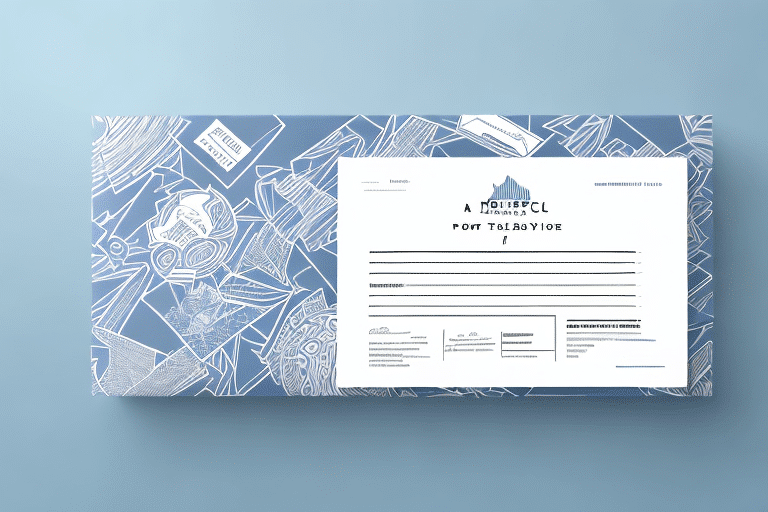How to Create a Professional Packing Slip
If you're in the business of shipping products, having a professional and well-organized packing slip is essential. A packing slip serves as a critical communication tool between your business and your customers, providing vital shipping information and details about the products they have ordered. This article explores the key aspects of creating a professional packing slip that adds value to your business, including its importance, essential elements, organization, customization, branding, printing, automation, legal requirements, and more.
Understanding the Importance of a Packing Slip for Your Business
A packing slip is a document that accompanies shipped goods, detailing the contents of the package, contact information for the seller, and other order specifics. Understanding the significance of a packing slip is crucial for any business owner. A well-designed packing slip not only confirms the customer's order but also aids in tracking the package and maintaining a record of shipped items. According to a 2023 Statista survey, 78% of customers consider accurate packing slips as a key factor in their overall satisfaction with a purchase.
Moreover, packing slips play a significant role in inventory management. By keeping a record of shipped items, businesses can efficiently track inventory levels, preventing stockouts and ensuring timely fulfillment of future orders. This contributes to operational efficiency and enhances customer satisfaction. Additionally, packing slips can be leveraged to include promotional materials or discount codes, encouraging repeat purchases and referrals. Overall, a professional packing slip is a valuable asset that streamlines operations, improves customer experience, and drives sales.
Key Elements to Include in Your Packing Slip
Including the right information on your packing slip is essential for effective communication and smooth shipping processes. A well-structured packing slip should contain the following elements:
- Order Number: A unique identifier for the order to facilitate tracking and reference.
- Date of Shipment: The date when the order was dispatched.
- Customer Information: Including the customer's name, shipping address, and email address.
- Itemized List: Detailed descriptions of the items shipped, including quantities, sizes, and any relevant specifications.
- Shipping Information: Tracking number, shipping carrier details, and estimated delivery dates.
- Special Instructions: Notes about handling fragile items, specific delivery instructions, or other pertinent details.
Including these elements ensures clarity and reduces the likelihood of errors or misunderstandings during the shipping process.
Organizing Your Packing Slip for Efficiency
Effective organization of your packing slip is vital for easy retrieval and use. Here are some best practices:
Logical Sequencing
Arrange information in a logical order, starting with the order number and customer information, followed by the itemized list and shipping details. This makes the packing slip easy to read and navigate.
Clear Formatting
Use clear and concise language, avoid unnecessary abbreviations, and choose a legible font size and style. This enhances readability and ensures that all essential information is easily accessible.
Attachment Method
Attach the packing slip securely to the outside of the package using adhesive pockets or shipping tape. This ensures that the packing slip remains with the shipment and is easily accessible to the recipient.
Regular Template Reviews
Periodically review and update your packing slip template to reflect any changes in business processes or information requirements. This ensures that the packing slip remains relevant and effective.
Designing a Professional and Branded Packing Slip
Customizing your packing slip to reflect your company's brand can enhance professionalism and strengthen brand identity. Consider the following design elements:
- Logo and Branding Colors: Incorporate your company logo and brand colors to create a cohesive and recognizable appearance.
- Consistent Layout: Maintain a consistent layout that aligns with your overall branding and marketing materials.
- Clear Typography: Use fonts that are easy to read and align with your brand's personality.
While branding is important, it's crucial to balance aesthetics with functionality. Ensure that the packing slip remains uncluttered and that all essential information is prominently displayed.
Including Essential Information
In addition to branding elements, ensure that all necessary information is included and clearly presented. This includes the customer's name and address, order number, item list, and any special instructions. A clear and detailed packing slip enhances the customer experience and minimizes the risk of errors.
Customizing Your Packing Slip to Meet Customer Needs
Personalizing your packing slip can significantly enhance customer relationships and satisfaction. Here are some customization strategies:
- Personal Messages: Include a personalized thank-you note or a special message for customers who have opted for gift packaging.
- Promotional Content: Add information about ongoing promotions, new products, or upcoming sales that may interest the customer.
- QR Codes: Incorporate QR codes that link to personalized content, such as thank-you videos or customer surveys, to engage customers further.
When customizing, ensure that the packing slip remains clear and uncluttered. Avoid overwhelming the customer with too much information, and prioritize readability.
Best Practices for Printing and Attaching Your Packing Slip
Proper printing and attachment of your packing slip can streamline the shipping process and prevent common issues:
High-Quality Printing
Use high-quality paper stock that can withstand handling and shipping without smudging or tearing. This ensures that the information on the packing slip remains legible throughout the shipping process.
Efficient Printing Methods
Consider using thermal or laser printers for efficient and high-speed printing, especially if you handle a large volume of orders. Batch printing can further enhance efficiency and reduce processing times.
Secure Attachment
Attach the packing slip securely to the package using adhesive pockets or shipping tape. This prevents the slip from becoming detached during transit and ensures that the customer receives it intact.
Internal Copies
Including a copy of the packing slip inside the package can be beneficial in case the external slip is damaged or detached. This provides the customer with a backup reference for their order details.
Automating the Creation of Your Packing Slips for Increased Efficiency
Automating the packing slip creation process can save time, reduce errors, and enhance overall efficiency. Here’s how automation can benefit your business:
Integration with Existing Systems
Utilize software and platforms that integrate seamlessly with your order management and inventory systems. This ensures that packing slips are generated automatically with accurate and up-to-date information.
Scalability
Automation allows your business to scale effectively. As order volumes increase, automated systems can handle the additional workload without compromising accuracy or speed.
Enhanced Customer Service
Automated packing slips can include additional information such as tracking numbers, delivery dates, and personalized messages. This improves the customer experience and fosters higher levels of satisfaction.
Error Reduction
Automation minimizes the risk of human error, ensuring that packing slips are consistently accurate and reliable. This reduces the likelihood of shipping mistakes that can negatively impact customer satisfaction.
Common Mistakes to Avoid When Creating a Packing Slip
Creating an effective packing slip requires attention to detail and adherence to best practices. Avoid the following common mistakes to ensure a smooth and efficient shipping process:
- Incomplete Information: Missing essential details such as order number, customer information, or item descriptions can lead to confusion and delays.
- Low-Quality Printing: Poor print quality can make the packing slip difficult to read, causing frustration for customers and potential shipping errors.
- Incorrect Attachment: Attaching the packing slip to the wrong package or using an incorrect shipping address can result in misplaced orders and dissatisfied customers.
- Lack of Verification: Failing to double-check the accuracy of the packing slip before sending can lead to mistakes such as incorrect product quantities or misspelled customer names.
By being mindful of these pitfalls and implementing thorough verification processes, you can enhance the reliability and professionalism of your packing slips.
Using Your Packing Slip as a Marketing Tool
Your packing slip can be a powerful marketing tool that promotes your business and fosters customer loyalty. Here are several strategies to leverage packing slips for marketing purposes:
- Promotional Messages: Include special offers, discount codes, or information about upcoming sales to encourage repeat business.
- Call-to-Action: Encourage customers to leave reviews, follow your social media accounts, or subscribe to your email newsletter.
- Product Recommendations: Suggest related products or accessories that complement the customer's purchase, increasing the chances of additional sales.
- Referral Programs: Promote referral incentives by offering discounts or rewards for customers who refer friends and family to your business.
Integrating these elements into your packing slip not only enhances the customer experience but also drives engagement and sales.
Personalized Recommendations
Including personalized product recommendations tailored to the customer's purchase can enhance the relevance of your marketing efforts. For instance, if a customer buys a camera, suggesting related accessories like lenses or tripods can increase the likelihood of additional purchases.
Referral Incentives
Implementing a referral program on your packing slip can expand your customer base through word-of-mouth marketing. Offer incentives such as discounts or free products for each successful referral, encouraging customers to share their positive experiences with others.
Including Clear Return Instructions on Your Packing Slips
Providing clear and concise return instructions on your packing slip is essential for maintaining customer trust and satisfaction. Clear return policies minimize confusion and facilitate a smooth returns process. Here’s what to include:
- Return Process: Step-by-step instructions on how to initiate a return.
- Return Timeline: Specify the time frame within which returns are accepted.
- Return Conditions: Outline any conditions for returns, such as item state or packaging requirements.
- Costs: Inform customers about any applicable restocking fees or return shipping costs.
Clear return instructions help prevent disputes and ensure that customers understand the process, enhancing their overall experience with your brand.
Legal Requirements for Packing Slips
Compliance with legal requirements is critical when creating packing slips. Depending on your location and industry, certain information may be mandated by law. Ensure that your packing slips include:
- Business Information: Your business name, address, and contact information.
- Tax Information: Applicable tax details, such as VAT or sales tax numbers.
- Product Information: Accurate descriptions and classifications of the shipped items.
- Compliance Labels: If applicable, include any required compliance or regulatory labels.
Consulting with a legal professional or referring to local regulations can help ensure that your packing slips meet all necessary legal standards.
Conclusion
A professional packing slip is more than just a shipping document; it is a valuable tool that enhances communication, improves operational efficiency, and fosters customer satisfaction. By focusing on key elements such as accurate information, effective organization, branding, customization, and automation, you can create packing slips that add significant value to your business. Avoiding common mistakes and adhering to best practices ensures a smooth shipping process and a positive customer experience. Additionally, leveraging packing slips as marketing tools and ensuring compliance with legal requirements can further strengthen your business operations and customer relationships.




















